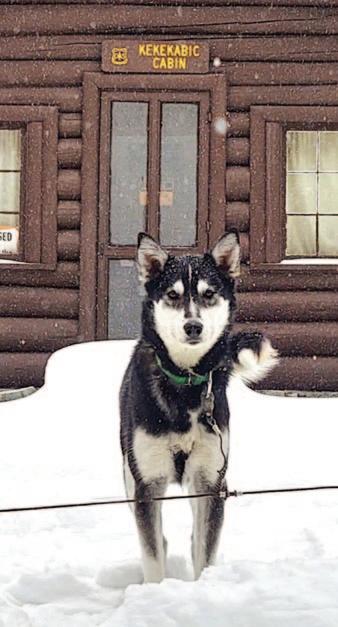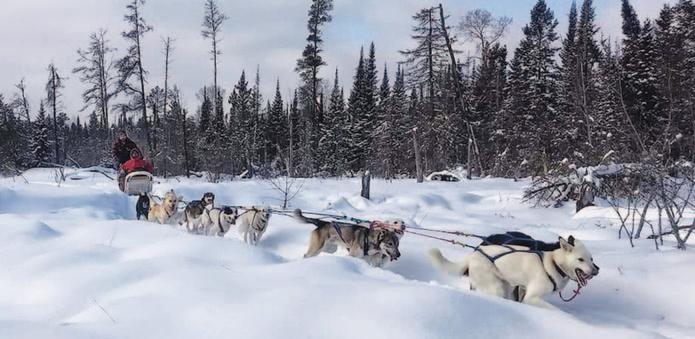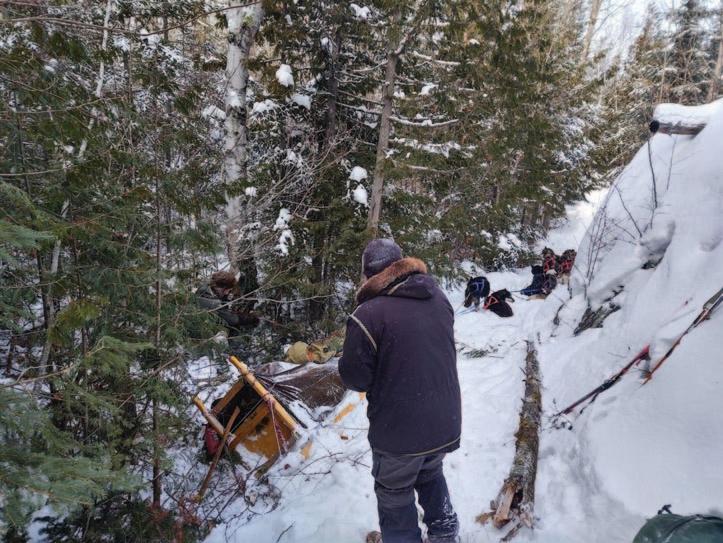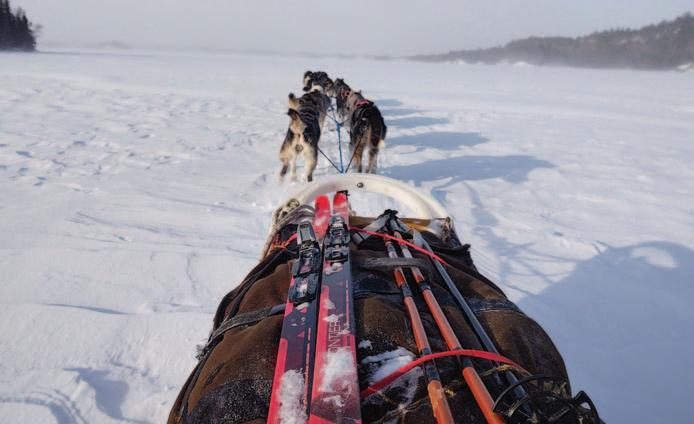
10 minute read
Kekekabic Adventure
Shuffling nervously in my sleeping bag, I strained to hear if Hugo could be alerting the rest of us to something. However, as I watched the most senior dogs continue to doze undisturbed, I realized that there were probably no predators nearby. This young pup was just anxious, and possibly a little confused on one of his first overnight trips into the Boundary Waters.
A few moments passed before Joe, the musher who had probably been sleeping peacefully inside his sled bag on the ice, called out to Hugo in an unsuccessful attempt to quiet him. I chuckled as my heart and mind began to slow again, sinking snuggly back into my sleeping bags and allowing myself to drift back to sleep. I was going to need the rest.
I was excited about this trip. A few weeks prior I had been asked to join two Forest Service mushers and another wilderness ranger to assist with a dogsled hauling mission into Kekekabic lake. Years ago, a historic wilderness cabin had its roof reshingled, and it was time to backhaul the debris out of the wilderness.
The Forest Service mushing program goes quietly unnoticed by the public. It is a program unique to the Superior National Forest and federal parks and forests in Alaska. Each winter, one or two teams of dogs and their mushers are responsible for hauling thousands of pounds of materials in and out of the Boundary Waters Canoe Area Wilderness. These materials include, but are not limited to, lumber for boardwalks and erosion control, latrines, fire grates, and garbage that has been left behind by


campers. There are no motors allowed within wilderness boundaries in winter. No cars, wagons, bicycles, or wheels of any sort. As you may have caught on by now, dogsledding fits none of those categories!
The next morning came quickly. Mushers Joe Friedmeyer and Tom Roach were busy down on the ice preparing their dogs’ meals. Dogs always eat first. Brian Bittner, a seasoned wilderness ranger, and I began to gather our gear and strap on our skis in preparation for breaking the last leg of the trail to Kekekabic Lake.
Before we took off, I headed down to the lake to scratch some ears. These Alaskan huskies had just finished their breakfast, which could be referred to as “slop” or a stew of sorts. This usually contains warm water, a variety of meat chunks, and some dry kibble. Immediately I was greeted by happy tails and wet, fish-breath kisses. It could be the coldest, most miserable morning on record and these dogs would still find a way to warm our souls—and we were going to need that warmth.
The day prior, Brian and I had skied roughly 16 miles from the Moose Lake landing to the winter trail between Knife and Bonnie Lakes. By January, there is a nicely packed trail from recreational mushers coming up to Knife for fishing trips. Skiing conditions were fair that morning with limited portions of the trail being blown over by snow. For the last five to six miles of our trip, we would be breaking fresh trails for the teams to follow up to Kekekabic Cabin.
The weather forecast did not seem favorable for the remainder of our adventure. High winds and temperatures dropping well below -20


would make traveling this unbroken stretch of snow and ice much more difficult, especially hauling a ton’s worth of shingles.
I was buzzing to go. Brian and I found our rhythm and we trekked our way across Bonnie, Spoon, and Pickle Lakes. I was in the lead at the end of the last portage when Kekekabic finally opened before me. This was my first visit to this border country lake, and let me tell you, the views are spectacular. Large, rolling, snowcovered ridges lined the shore of this long narrow lake. Sheets of snow were being driven across the frozen surface as the wind funneled strongly from the west, gusting against our backs as we continued across the trackless snow.
At one point I looked over my shoulder to notice the dog teams quickly closing the gap behind us. We had just about made it to the shoreline by the cabin when the dogs passed us, quickly disappearing off the lake and into the trees. It wasn’t long before I could hear their excited yelps and barking, a sure sign that they had stopped but would definitely prefer to keep going. I, however, was looking forward to a relaxing evening of chores and planning for the next day.
As we dug out the old shingles and loaded them into the dogsled, Joe and Tom quickly realized that this was going to be a muti-load trip. There was no way we could haul a ton of shingles plus our gear all the way back to Moose Lake in one trip. The amount of weight in the sled was the concern, especially on one of the portages back to Knife Lake where we would have to set up rigging to belay both dogsleds down a steep rock face. The dogs were able to navigate uphill on this section with some maneuvering, but the way back down was treacherous.
That night, after the dogs had been fed, firewood cut, and water collected, we hunkered down next to the warmth of the wood stove while the mushers made a plan. I tuned my radio to the weather report—winter storm warning in effect for the next 48 hours. Temperatures were expected to drop below -40 with winds gusting 30-40 mph. Everyone in the group had experience working in these conditions, however the forecasted weather spelled trouble for more than one reason.


Traveling in these conditions is dangerous for the unprepared. Safety of the dog teams and humans needed to be the top priority. Tom and Joe decided that the shingles would not be hauled all the way back to the landing yet; they would be staged at Knife Lake for pick up later in the mushing season. Tomorrow both teams would mush the shingles out to Knife and return to the cabin, and the following day we would make the 22-mile trek out of the wilderness.
With that, we all settled in for the night, feeling thankful for the welcoming warmth the wood stove would be providing us during the subzero temperatures to come.
By the following afternoon, I found myself rope in hand, helping to ease a thousand-pound dogsled down the sloping side of a rock face. The teams approached this section downhill, on a precarious 90-degree corner. The mushers had to do everything in their power to make sure they could get their team to stop, taking into account the extra weight of the load. It was critical to ensure the sled could be hooked to the belay system before making the corner.
Before belaying the sled, the dogs were led down the steep section one at a time and safely tied out on the lake below, waiting for their dogless sled to be delivered to the bottom of the rocky slope. This was slow, careful work. The end of this portage was unforgiving. Tensions were high, but after almost two hours all dogs, humans, and sleds had made it down the rock face unscathed. Talk about an adrenaline rush!
As the mushers continued on the trail broken from the day before, we skiers were able to take a muchneeded break. The winds had picked up across the lakes, so we took a sheltered lunch in the trees along the portage. I could feel the effects of cumulative fatigue starting to linger in my body. Working in the winter, especially in these conditions, is different from any other work I've experienced—my body working overtime trying to keep warm and


function in a physically challenging environment. I was constantly snacking and drinking the warm water from my thermos to keep my energy levels high.
I knew I couldn’t stay stagnant too long before I would begin to chill. Brian and I headed back to the cabin to collect some extra firewood before the dog teams returned, then we hunkered down for our final night.
Warmth. My fingers found warmth buried beneath the thick coat of Ely, one of Tom's huskies. It was a cold morning. The coldest of the days so far—the kind of cold that burns your nose and makes your eyelashes freeze together. Yet this team of heavily coated sled dogs, who had just spent the night outside, were as perky as ever, ready to get the day started.
The trails across Kekekabic were only partially blown in as my skis swished slowly over the surface of the snow, straight into the wind. I quickly realized a mistake. The layers I had


worn the previous days were not enough to protect me from the gales we were experiencing today. My legs and toes became painfully chilled a half an hour into my ski. I had stashed extra layers in my gear bag in the dogsled behind me and was thankful to grab them before continuing to Knife Lake.
The first half of the journey was slow but smooth. We were able to locate our trail under blown-over drifts and find some traction for the sleds. At this point, Tom and Joe invited Brian and me to ride in the dogsleds, since the teams were making steady progress along the trail. I threw on the last of my layers and tucked myself inside the sled bag, which offered a little protection from the wind.
As the day wore on, the wind strengthened, the temperature dropped, and we moved slower and slower. The dogs began to lose the trail under the freshly blown snow and tried to veer off the path to run along the shoreline. I repeatedly jumped off the sled to help keep them on course and to see if I could find the trail myself, to no avail.
Fatigue hung over the lot of us during the final stretch on Moose Lake. The dogs' eyes and faces were covered in ice, and the beards on the faces of their human counterparts were just as frosty. The wind was doing its best to rip the hood of my ruffed jacket off my head. I could feel its force ripping through every seam and fold of my anorak and layered trousers.
We were experiencing winter in her fullest, brutal force. Humbled by the resiliency and heart of the dogs, I watched them power through some of the toughest conditions these mushers had ever experienced.
There came a point where it no longer made sense for me to ride on the sled. The dogs continued to


struggle to find the trail and were pulling slower by the minute. Instead, I stayed up front with the lead dogs, trudging slowly through the snow, doing my best to encourage them to head southwest towards the landing.
Finally, I could see it! Moose Lake landing. The sun was starting its descent towards the horizon as I looked back to watch the dogs make their final push off the lake, up the hill, and to their dog boxes. Three days, 50 miles of skiing, 45 mile-anhour winds, and temperatures dropping below -40. As exhausted as I was for the days following this trip, I couldn’t help but feel exhilarated. I believe we all had just experienced the wilderness in her wildest form. It was truly unforgettable. The author











